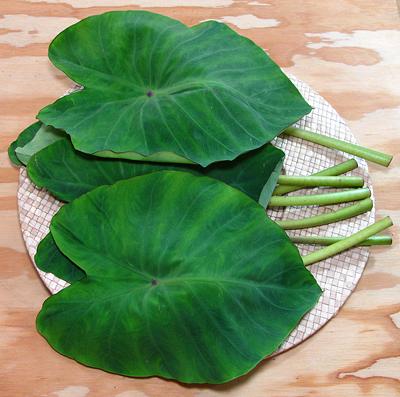
[Taro (Polynesian); Kalo (Hawaiian); Colocasia (Rome); Kolocasi (Cyprus); Ocumo, Cocoyam, Madumbi, Nduma (Africa); Macabo (Cameroon); Khoai mo, khoai so (Vietnam); Laing (Philippine); Dasheen, Eddoes (Caribbean); Malanga cabeza, Malanga islena (Cuba); Arvi, Colocasia (India); Talas (S.E. Asia); Dalo (Fiji); Cara (Brazil); Calaloo (Caribbean, leaves only); Yautia (Puerto Rico); Colocasia esculenta]
Taro leaves are, of course, grown wherever Taro Corms are grown (see our Taro / Colocosia page). They are edible, and are cooked and eaten similarly to Spinach in most of those regions. They do need more careful treatment than Spinach as their content of Oxalic Acid and Calcium Oxalate are much higher.
Note that Taro Leaves can easily be confused with Malanga Leaves which have much lower Oxalate content. They are easy to tell apart. The stem of a Malanga leaf joins the leaf right at the point of the "V" notch. As you can see from the photo, Taro leaf stems join the leaf several inches inward from "V" notch.
While these leaves have been pretty much unavailable in North America, they are now showing up in Philippine markets here in Los Angeles (2017), and are selling very well when they appear. The photo specimens, purchased from a Philippine market in Los Angeles (Eagle Rock), were 15 inches long. The leaves were typically 10-1/2 inches long and 7-1/2 inches wide. A 1.82 pound (29 ounces) bunch yielded 14 ounces of leaves (48%) and 15 ounces of stems. Cost was 2017 US $5.99 / pound.
More on Arums.
See also Taro / Colocasia Corms.
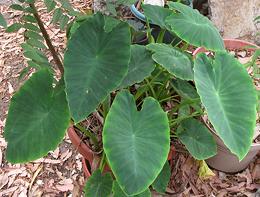 [Gabi (Philippine)]
[Gabi (Philippine)]
Young taro leaves are commonly used in the cooking of West and Central Africa. They are also used in Hawaii (Luau) and other Pacific islands, and especially in the Philippines. Taro leaves should be used carefully and not to excess, as they are high in Oxalic Acid and Calcium Oxalate (see Health & Nutrition). They should always be wet cooked and consumed with plenty of other ingredients.
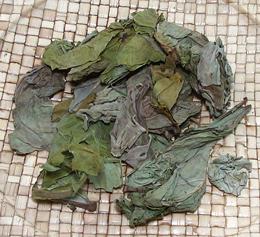 [Pinatuyong Dahon ng Gabi (Philippine)]
[Pinatuyong Dahon ng Gabi (Philippine)]
Dried Taro Leaves are available in Philippine markets. Many Filipinos prefer them for availability, storability, and under the false presumption that sun drying reduces the Oxalate content. Oxalic Acid is not volatile and even baking won't drive it off - it's long wet cooking that does the job. Of course appearance will be different from fresh leaves because they will be quite dark, and the flavor will be a bit different due to drying.
To make the rough equivalent of 1 pound of fresh leaves (stems
removed) you would need about 2-1/2 ounces of dried leaves. 2 cups
of dried leaves moderately packed is about 1-3/8 ounces, so you'd need
almost 4 cups to be equivalent to 1 pound fresh.
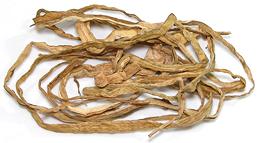 Taro stems are called for by some recipes in India (Colocasia stem, usually
fresh) and Korea (To-ran, fresh and dried). They contain both soluble Oxalic
Acid and non-soluble Oxalates in various proportions, but figure about half
and half. They are not as bad as leaves, but should still be used cooked
like leaves and eaten with plenty of other ingredients.
Taro stems are called for by some recipes in India (Colocasia stem, usually
fresh) and Korea (To-ran, fresh and dried). They contain both soluble Oxalic
Acid and non-soluble Oxalates in various proportions, but figure about half
and half. They are not as bad as leaves, but should still be used cooked
like leaves and eaten with plenty of other ingredients.
Yield: One ounce of dried stems
will be 5 ounces after soaking overnight.
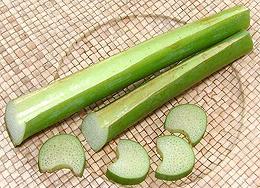 [Bac Ha (Viet - South and U.S.); Doc Mung, Roc Mung (Viet - North);
Indian Taro; Hasu-imo, Ryukyu (Japan); Manto de Eva (Chile);
Colocasia gigantea]
[Bac Ha (Viet - South and U.S.); Doc Mung, Roc Mung (Viet - North);
Indian Taro; Hasu-imo, Ryukyu (Japan); Manto de Eva (Chile);
Colocasia gigantea]
Not exactly Taro, but often sold as "Taro Stems" or "Colocasia Stems".
This plant is native to Southeast Asia, and is thought to be a natural
cross between Alocasia macrorrhizos (Giant Elephant Ear) and
Colocasia esculenta (Taro).
The stems are eaten as a vegetable in Southeast Asia, particularly
in soups in Vietnam, and in Japan. The root corms of this species are
fibrous and inedible, and the leaves are not particularly edible either.
Details and Cooking.
Disclaimer: information in this section is from publicly available literature, and can not be taken as medical advice. For medical advice, refer to licensed health care practitioners.
Taro leaves are highly nutritious, with a good spread of vitamins, minerals, protein and antioxidants. They are also well known for a negative: Oxalic Acid and Calcium Oxalate.
There are a whole lot of shrill articles on the Internet about the danger of consuming Oxalates (a designation that usually includes Oxalic Acid). Reputable medical research shows this to not be the case except for a very few people who have particular genetic defects, or people on crank diets, or taking supplements in excess, particularly vitamin C, or who eat high Oxalic Acid plants to excess.
Oxalic acid does combine readily with metals such as Calcium, Iron and Magnesium, making them unavailable to the body. Again, there are a lot of shrill Internet articles warning about this, but reputable medical research has shown it to be a non-problem for people getting adequate nutrition. Some recommend that if you are eating a lot of foods high in Oxalic Acid, to combine them with foods high in Calcium. The Oxalic Acid can combine with the Calcium in the digestive tract to form Calcium Oxalate, which is not much absorbed into the body. Actually, leafy greens containing Oxalic Acid usually have plenty of calcium as well.
In Taro Leaves, Stems and Corm Skins, and sometimes the corms themselves, the calcium oxalate is in the form of very sharp needle like crystals called raphides. These crystals are specifically designed for defense, and designed to inject damaging substances when they penetrate mucous membranes, resulting in extreme discomfort, swelling and pain. Many people shy away from fresh leaves for this reason.
These raphides are not soluble in water, but are soluble in Hydrochloric Acid (stomach acid). They are not soluble in Acetic Acid (vinegar), but are soluble in Citric Acid (lemon / lime juice). Apparently they can be broken up by long cooking, because Taros riddled with them are eaten after a long (sometimes hours) boiling.
How dangerous these crystals are depends on plant cultivars. Domesticated cultivars are generally much less of a problem than wild plants. In the Philippines, dried Taro Leaves are most used, for availability, storability, and under the presumption that sun drying removes the Oxalates. This is not at all the case, as Oxalic Acid is not volatile. Even baking doesn't drive it away, it is wet cooking that removes Oxalic Acid, from dried leaves as well as fresh.
Reduction of Oxalates is generally done by extensive boiling and changing the cooking water. Some Taros, like Giant Swamp Taro, take a whole lot of boiling to be safe to eat. In some plants, the raphids become encased in starches during cooking and cause no problem. It is best to avoid the parts of the plant that include raphides, and especially avoid wild plants.
am_tarolz split 170616 r 220113 www.clovegarden.com